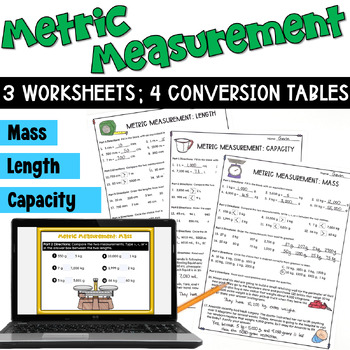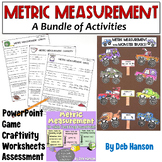Metric Measurement Worksheets: Length, Mass, Capacity, & Conversion Tables
- PDF
- Easel Activity
What educators are saying
Also included in
- This metric measurement bundle has everything you need to teach upper elementary students about the metric measurements for length, mass, and capacity. The activities in this math bundle make learning how to use metric measurements fun and understandable! Students love the activities while teachersPrice $13.00Original Price $21.50Save $8.50
Description
Do your students struggle with metric measurement conversions and concepts? This is such a difficult math standard for many students. This set of three worksheets and four conversion tables will provide an additional opportunity for your students to practice interacting with various metric measurement tasks, such as computing equivalent measurements, comparing two measurements, and ordering a set of measurements from least to greatest.
This metric measurement resource contains four worksheets.
- Metric Length (mm, cm, m, & km)
- Mass (g & kg)
- Metric Capacity (mL & L)
- 4 Conversion Tables
The first three worksheets follow the same pattern:
Part 1- Fill in the blank with an equivalent measurement.
Part 2- Compare the two measurements. (<, >, or =)
Part 3- Order the measurements from least to greatest.
Part 4- Multiple Choice- Circle the list that is ordered correctly from greatest to least.
Part 5- Two Word Problems
Answer keys are included.
********This resource is available in TWO FORMATS:
- TRADITIONAL PRINTABLES- Print the PDF and distribute paper copies to your students to complete.
- TPT EASEL ACTIVITY- Students can complete this colorful version on a device. Students type in text boxes or move images to complete each task. This Activity includes 14 slides!
CHECK OUT THE PREVIEW!
I created these worksheets as a follow-up activity to my Metric Measurement PowerPoint! Click on the following link if you want to check it out:
Metric Measurement PowerPoint with 90 slides!
Copyright by Deb Hanson
This item is a paid digital download from my TpT store
www.teacherspayteachers.com/Store/Deb-Hanson
This product is to be used by the original downloader only. Copying for more than one teacher is prohibited. This item is also bound by copyright laws. Redistributing, editing, selling, or posting this item (or any part thereof) on an Internet site that is not password protected are all strictly prohibited without first gaining permission from the author. Violations are subject to the penalties of the Digital Millennium Copyright Act. Please contact me if you wish to be granted special permissions!







